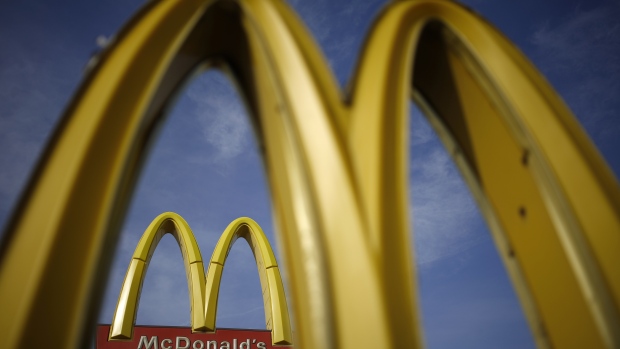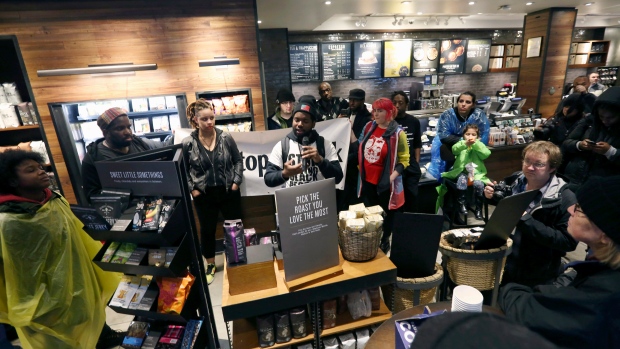Apr 18, 2018
How McDonald's could boost its hangout status as Starbucks faces backlash
, Bloomberg News

Despite decades of pushing to create a welcoming coffeehouse culture in the U.S., Starbucks Corp. has left many Americans behind. McDonald’s Corp. may be ready to pick up the pieces.
The arrest last week of two black men at a Philadelphia Starbucks has put the company at the center of national concerns about racial inequality. Starbucks cafes tend to be located in relatively affluent, disproportionately white areas, according to data analyzed by Bloomberg. So its bid to cultivate a “third place” -- a location between home and work where customers can relax and have a conservation -- naturally caters to the customers who live nearby, even as its marketing promotes more racial diversity.
According to Bloomberg’s analysis of information from AggData and the U.S. Census Bureau, Starbucks neighbourhoods skew less black than the surrounding population. Across the U.S., ZIP codes including at least one Starbucks location are 9.9 per cent black and 59.1 per cent white. That compares with an overall population that’s 12.1 per cent black.
“They could absolutely be doing more if this was truly a strong value of theirs,” said Rosalind Chow, an associate professor of organizational behavior and theory at Carnegie Mellon University.
McDonald’s Opportunity
The mantle of creating a true “third place” actually may fall to another, less idealistic chain: McDonald’s. The restaurant is a popular hangout for a wide range of demographics. And despite having roughly the same number of U.S. locations as Starbucks, its restaurants are more representative of America.
ZIP codes including at least one McDonald’s restaurant are 13.2 per cent black and 58.7 per cent white. McDonald’s also is predominantly run by independent operators, giving it a more diverse ownership group. Since the early 1970s, the company has had an organized group of black franchisees -- a coalition once overseen by Herman Petty, the first African-American owner of a McDonald’s. Petty opened a location in inner-city Chicago in 1968.
In the late 1990s, Starbucks teamed up with Magic Johnson Enterprises to invest in stores in underserved neighborhoods. The partnership ended in 2010, but after the demonstrations in Ferguson, Missouri, in 2015, the company recommitted to opening cafes in poor urban neighborhoods, and has opened 10 in cities including Chicago and Trenton, New Jersey, and says it’s planning another in Birmingham, Alabama, this summer.
“Each of these stores is thriving,” Seattle-based Starbucks said in an emailed statement. Additionally, the chain has hired 50,000 “opportunity youth” -- young people who aren’t in school and don’t have a job.
“Businesses have a role and responsibility to tackle societal challenges head on,” the company said.

Demonstrators occupy the Starbucks that has become the center of protests Monday, April 16, 2018, in Philadelphia. (AP Photo/Jacqueline Larma)
Failed Campaign
Starbucks also has attempted to spur a national conversation on race -- a move that included baristas writing “Race Together” on coffee cups -- but the campaign was largely mocked on social media.
Now, Philadelphia has become a flashpoint for the chain. Last week, the manager of a store near the affluent Rittenhouse Square area summoned the police after two black men sat at a table. They hadn’t ordered anything yet, but that’s not uncommon at a chain where patrons frequently sit and tap away at laptops.
“I’m embarrassed, ashamed; I think what occurred was reprehensible at every single level,” Chairman Howard Schultz said in an interview on CBS This Morning. “I take it very personally as everybody at our company does and I’m committed to making it right.”
The arrests brought protests and social-media outcry, and Chief Executive Officer Kevin Johnson scrambled to address the fallout. He apologized for the incident and traveled to the city to meet the men who were arrested. Starbucks also plans to temporarily close more than 8,000 company-owned locations next month for bias training.
Millions of Dollars
“It will cost millions of dollars but I’ve always viewed this and things like this as not an expense but an investment in our people and our company,” Schultz told CBS, referring to the store closing decision.
The arrests “destroy the community feeling that the company had striven to create,” said Pat Tomaino, director of socially responsible investing at Zevin Asset Management. The investor, who holds about 60,000 Starbucks shares, sent a letter to the company’s executives on Tuesday. He wants a public report on causes, an investigation of other incidents, and a review of policies.
Starbucks’s Philadelphia footprint mirrors the trend nationally. ZIP codes with at least one Starbucks location in the area are 28.7 per cent black and 47.5 per cent white, the data show. The overall population there is 41.5 per cent black and 35.3 per cent white. The cafe where the police were called serves a neighborhood that’s about 5.9 per cent black and 74.3 per cent white.
“Incidents like the arrests in Philadelphia are not only morally reprehensible, but they also undermine the community feeling that Starbucks tries to create,” Tomaino said. “To reduce risk, managers need more training and guidance.”
--With assistance from Jeff Green Justina Vasquez Kevin Varley and Emily Chasan



